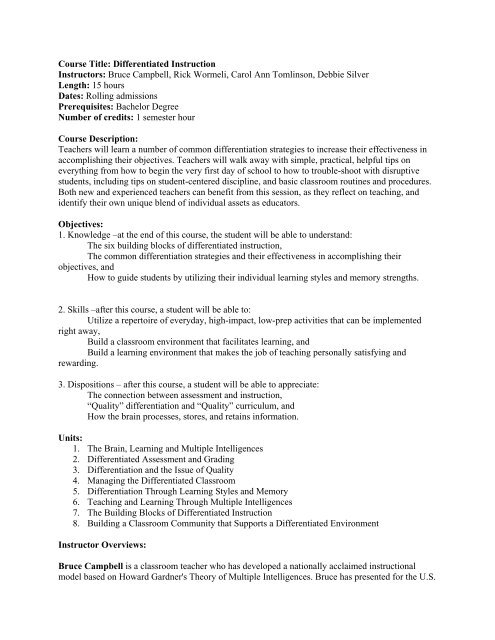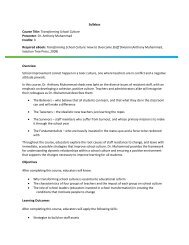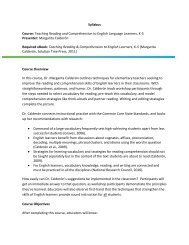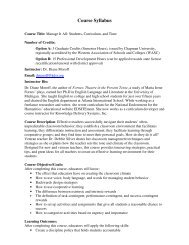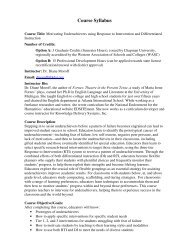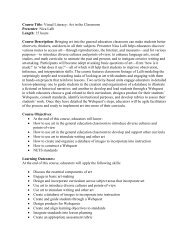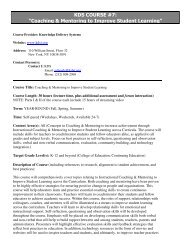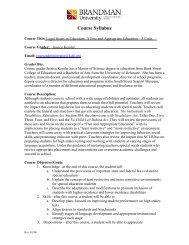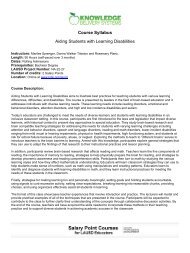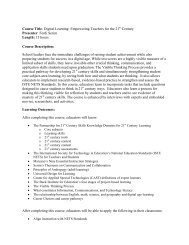Course Title: Differentiated Instruction Instructors: Bruce Campbell ...
Course Title: Differentiated Instruction Instructors: Bruce Campbell ...
Course Title: Differentiated Instruction Instructors: Bruce Campbell ...
You also want an ePaper? Increase the reach of your titles
YUMPU automatically turns print PDFs into web optimized ePapers that Google loves.
<strong>Course</strong> <strong>Title</strong>: <strong>Differentiated</strong> <strong>Instruction</strong><br />
<strong>Instructors</strong>: <strong>Bruce</strong> <strong>Campbell</strong>, Rick Wormeli, Carol Ann Tomlinson, Debbie Silver<br />
Length: 15 hours<br />
Dates: Rolling admissions<br />
Prerequisites: Bachelor Degree<br />
Number of credits: 1 semester hour<br />
<strong>Course</strong> Description:<br />
Teachers will learn a number of common differentiation strategies to increase their effectiveness in<br />
accomplishing their objectives. Teachers will walk away with simple, practical, helpful tips on<br />
everything from how to begin the very first day of school to how to trouble-shoot with disruptive<br />
students, including tips on student-centered discipline, and basic classroom routines and procedures.<br />
Both new and experienced teachers can benefit from this session, as they reflect on teaching, and<br />
identify their own unique blend of individual assets as educators.<br />
Objectives:<br />
1. Knowledge –at the end of this course, the student will be able to understand:<br />
The six building blocks of differentiated instruction,<br />
The common differentiation strategies and their effectiveness in accomplishing their<br />
objectives, and<br />
How to guide students by utilizing their individual learning styles and memory strengths.<br />
2. Skills –after this course, a student will be able to:<br />
Utilize a repertoire of everyday, high-impact, low-prep activities that can be implemented<br />
right away,<br />
Build a classroom environment that facilitates learning, and<br />
Build a learning environment that makes the job of teaching personally satisfying and<br />
rewarding.<br />
3. Dispositions – after this course, a student will be able to appreciate:<br />
The connection between assessment and instruction,<br />
“Quality” differentiation and “Quality” curriculum, and<br />
How the brain processes, stores, and retains information.<br />
Units:<br />
1. The Brain, Learning and Multiple Intelligences<br />
2. <strong>Differentiated</strong> Assessment and Grading<br />
3. Differentiation and the Issue of Quality<br />
4. Managing the <strong>Differentiated</strong> Classroom<br />
5. Differentiation Through Learning Styles and Memory<br />
6. Teaching and Learning Through Multiple Intelligences<br />
7. The Building Blocks of <strong>Differentiated</strong> <strong>Instruction</strong><br />
8. Building a Classroom Community that Supports a <strong>Differentiated</strong> Environment<br />
Instructor Overviews:<br />
<strong>Bruce</strong> <strong>Campbell</strong> is a classroom teacher who has developed a nationally acclaimed instructional<br />
model based on Howard Gardner's Theory of Multiple Intelligences. <strong>Bruce</strong> has presented for the U.S.
Department of Education and numerous state departments of education; has consulted for schools,<br />
districts, and universities worldwide; and is a popular keynote speaker.<br />
Rick Wormeli is a Nationally Board Certified Teacher and a columnist for NMSA's magazine,<br />
Middle Ground. He is also the author of Meet Me in the Middle: Becoming an Accomplished Middle<br />
Level Teacher and Day One and Beyond: Practical Matters for New Middle Level Teachers. Rick<br />
won the outstanding English Teacher of the Nation Award at Disney's American Teacher Awards in<br />
1996. He has been a consultant to both the White House and the Smithsonian Institution.<br />
Carol Ann Tomlinson is a reviewer for eight journals and a section editor for one. She is author of<br />
over 100 articles, book chapters, books, and other professional development materials including How<br />
to Differentiate <strong>Instruction</strong> in Mixed Ability Classrooms. She works throughout the U.S. and abroad<br />
with teachers whose goal is to develop more responsive heterogeneous classrooms.<br />
Dr. Debbie Silver has been an invited author for several educational journals and has given keynotes<br />
at state, national, and international conferences. She has been a featured teacher for the PBS Online<br />
Teacher Chat, and has worked with educators in 46 states, Canada, Asia, and Europe.<br />
Methods of <strong>Instruction</strong>:<br />
• Video lectures and PowerPoint presentations<br />
• Short answer quizzes<br />
• Graded post assessments<br />
• Final<br />
All steps listed under each topic must be completed to receive credit for the course. No<br />
partial credit will be given. Students must earn a minimum of 60% to pass the course.<br />
Percentage of <strong>Course</strong> Credit<br />
• Graded post assessments and short answer quizzes 40%<br />
• Final Project 60%<br />
KDS Rubric for GA courses (passing requirements: 60 points):<br />
A: 90 - 100 points<br />
B: 80<br />
C: 70 points<br />
D: 60 points<br />
F: Fewer than 60 points<br />
Component<br />
Critical thinking<br />
post-work<br />
Unsatisfactory<br />
(10 points)<br />
Critical thinking<br />
post-work:<br />
Basic<br />
(20 points)<br />
Critical thinking<br />
post-work:<br />
Proficient<br />
(30 points)<br />
Critical thinking<br />
post-work:<br />
Distinguished<br />
(40 points)<br />
Critical thinking<br />
post-work:<br />
And<br />
0-40% correct<br />
60% correct<br />
80% correct<br />
100% correct
Short answer<br />
quizzes<br />
Short answer quiz:<br />
-Participant<br />
included no<br />
content from the<br />
course in his or her<br />
responses<br />
Short answer quiz:<br />
-Participant<br />
included some<br />
content from the<br />
course, usually<br />
appropriate, in his<br />
or her responses<br />
Short answer quiz:<br />
-Participant<br />
included<br />
appropriate<br />
content from the<br />
course in his or her<br />
responses<br />
Short answer quiz:<br />
-Participant<br />
provided rich<br />
detail from the<br />
content of the<br />
course in his or her<br />
responses<br />
Final<br />
-Participant did not<br />
address the<br />
questions posed<br />
Unsatisfactory<br />
(30 points)<br />
-Participant<br />
answered the<br />
questions directly,<br />
not always fully<br />
Basic<br />
(40 points)<br />
-Participant made<br />
thoughtful<br />
comments in direct<br />
response to the<br />
questions<br />
Proficient<br />
(50 points)<br />
-Participant made<br />
his or her<br />
responses to the<br />
questions<br />
personally<br />
meaningful<br />
Distinguished<br />
(60 points)<br />
Requirements of<br />
Assignment:<br />
Requirements of<br />
Assignment :<br />
Requirements of<br />
Assignment:<br />
Requirements of<br />
Assignment:<br />
-The assignment is<br />
substantially<br />
incomplete<br />
-Many<br />
requirements met,<br />
but a few pieces<br />
are missing, while<br />
others are<br />
underdeveloped—<br />
e.g., missing<br />
reflection or rubric<br />
or scant reflection<br />
and vague rubric<br />
-Participant has<br />
fulfilled all the<br />
requirements of<br />
the assignment.<br />
-All requirements<br />
gone beyond the<br />
requirements of<br />
the Assignment.<br />
e.g., inclusion of<br />
rubric, reflection,<br />
objective(s), etc.—<br />
whatever the<br />
directions indicate<br />
Form:<br />
Form:<br />
Form:<br />
Form:<br />
- Plentiful<br />
grammatical<br />
mistakes<br />
-Confusing content<br />
-Missing<br />
documentation of<br />
sources<br />
-Distracting<br />
grammatical errors<br />
-Confusing content<br />
-Inconsistent or<br />
missing<br />
documentation of<br />
sources<br />
-Participant has<br />
written a solid<br />
essay or lesson<br />
plan, including<br />
appropriate detail<br />
and in an<br />
interesting style.<br />
-No grammatical<br />
errors<br />
-Eloquent<br />
expression<br />
-Proper citation of<br />
sources<br />
Content:<br />
Content:<br />
Content:<br />
Content:<br />
-No main idea<br />
and/or main idea is<br />
irrelevant to the<br />
assignment<br />
-No apparent<br />
paragraph<br />
-The main idea is<br />
not clear in the<br />
opening paragraph<br />
-Relevance to<br />
main idea of<br />
supporting<br />
-Essay is<br />
organized around a<br />
thesis or main<br />
idea,<br />
-Paragraphs are<br />
organized around<br />
-Essay is<br />
organized around a<br />
thesis or main idea<br />
-Paragraphs are<br />
organized around<br />
ideas relevant to
organization<br />
-No supporting<br />
evidence for<br />
supporting ideas<br />
-No evidence in<br />
the lesson plan—in<br />
objectives,<br />
activities, or<br />
assessments—that<br />
the learner<br />
comprehends the<br />
course content<br />
paragraphs is not<br />
always clear<br />
-Supporting ideas<br />
are only minimally<br />
illustrated by<br />
examples or quotes<br />
-The lesson plan<br />
does not show<br />
enough evidence<br />
that the learner<br />
understands the<br />
course content.<br />
Objectives and/or<br />
activities and/or<br />
assessments only<br />
vaguely apply to<br />
the course content<br />
ideas relevant to<br />
the main idea<br />
-Supporting ideas<br />
are evident, and<br />
usually include<br />
illustrating<br />
examples and/or<br />
quotes<br />
-The lesson plan<br />
shows evidence of<br />
understanding of<br />
the course content<br />
in its objectives,<br />
activities, and/or<br />
assessments<br />
the main idea<br />
-Supporting points<br />
are illustrated with<br />
examples and/or<br />
quotes<br />
-Lesson plan<br />
shows evidence of<br />
a deep<br />
understanding of<br />
course content and<br />
participant uses<br />
that understanding<br />
to create<br />
opportunities for<br />
students to<br />
authentically show<br />
what they have<br />
learned.


